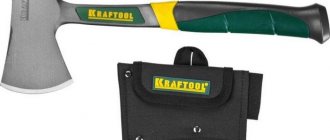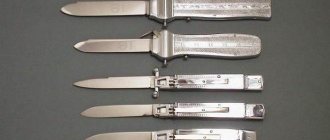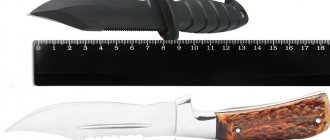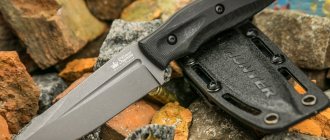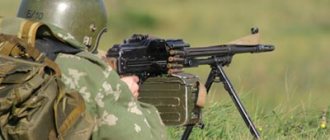No hiking trip would be complete without a camping knife, which is a tool for all occasions. A good weapon will help you out in any situation, but a bad one of poor quality will let you down. Therefore, in this article we will figure out how to choose a high-quality tourist knife, what to look for, whether to choose a folding knife or not, which models are best suited for fishing and hunting, whether it is worth taking a multifunctional tool, and we will highlight the rating of the best products.
Hiking knife.
Why do you need a knife on a hike?
Of course, a knife is one of the most useful tools in almost any area of life. However, when you choose a weapon for yourself, you should first of all understand: “why are you taking it for?” And if you answered that you need it for a hiking trip, you should ask yourself: “why is it needed there in general?” Based on this, you will decide in the future which specific model to choose.
A high-quality tool will come in handy during short stops and on weekend hikes, where you will use it to cut food. You will actively use it in preparing camp food. If you are going on a multi-day hiking trip, then when setting up a solid camp, a reliable model will take a very direct part:
- sharpening of pegs;
- cutting branches and small twigs;
- organizing a fire and hanging it.
There are a very large number of tasks.
What is it needed for?
A knife is an indispensable item when traveling. He will come to the rescue in a situation when you need:
- cut food;
- cut up an animal carcass or gut a fish;
- open canned food;
- cut mushrooms;
- cut branches and wood chips for the fire;
- cut skewers, fishing rods, stakes, oars;
- cut the rope;
- produce first aid aids - splints, crutches, stretchers;
- protect yourself from animals.
Types of knives and their purpose
Based on the far from complete list of tasks on a hike, we can already conclude that it will not be possible to find a universal camping knife. Experienced tourists usually have two or more knives for different tasks: one “table”, others for rougher work. For kitchen purposes, thinner folding travel knives are often used, but for serious tasks it is worth choosing a high-quality fixed knife, especially if the blade is integral with the handle, which increases its strength and safety during use.
And it’s also worth paying attention to multifunctional knives, which can come in handy at the most unexpected moment. The recognized leader in this segment are knives from Victorinox.
Folding tourist knife.
Useful video
Watch this video for a review of the 5 best camping knives:
Similar articles
- Hunting knives: basic and best types, sizes, how...
What are the best hunting knives used for both professionals and beginners. What are the parameters of knives for hunting: sizes, sheaths, steel, shape. How to choose a knife, make it yourself. How much does a knife cost, how to buy a good one for hunting, fishing and tourism. Read more - Folding knives: what type of folding knife is better...
What types of folding knives are there, how to choose the best in Russia and foreign manufacturers (American, Czech). How much do the budget and most expensive ones cost? What legendary and unusual knives are there, women's, on bearings, folding with a double blade. Read more
- Tactical knife: what is it, the best American...
What types of tactical knives are there, what are they? Which are the best among Russian and American production? Which knife is considered a tactical kitchen knife and which one is considered a survival knife. Which are included in the TOP for concealed carry among urban ones. Read more
- Cool knives: rating of the most expensive, legendary...
How to find the coolest knives with the best blade, kitchen, survival, dangerous, sharp. What are the legendary and most expensive ones? Which manufacturers and craftsmen are among the TOP best in the world. What rare budget and expensive ones are there in Russia? Read more
- Types of knives: what are there for kitchen, table...
Main types of knives in Europe and Asia. Varieties by affiliation and classification by origin. What are the shapes, what are the parts called, types of triggers and blades. Which ones relate to kitchen, combat, hunting. Read more
How to Choose the Best Camping Knife
To begin with, let’s once again pay attention to the basic principles of choosing a camping knife for a tourist:
- functionality – what and why you are buying this or that model. If there is no goal, then you will take it, rather, for beauty and “to be”;
- average thickness of the blade so that it does not break during use;
- simplicity - both in the shape of the blade and in the handle;
- high-quality scabbard;
- bright color so that it can be easily found on the ground, in thickets or in the snow;
- A tourist knife is a useful tool, a lifesaver, so it shouldn’t be too expensive, but should be...see the first point.
Next, let's look at the details and components of the hiking tool.
Blade
The best weapons for a hike are models with a thick butt. The tasks that sometimes arise on a hike can be incredibly tough and blades of normal thickness, as the practice of many tourists show, simply cannot withstand the load. The most common blade thickness is considered to be 5/32″ - 1/4″.
Blade shape
The most common shapes for tourist knives are:
- Concave (finish-shaped) blades have a thin tip that is great for digging and prying. The curved section can be sharpened at the top, which upgrades it into a hunting knife;
- Spear-shaped - the line of the butt decreases, as in penknives. This shape is quite durable and has an excellent cut. Models of this shape are poorly suited for delicate work, but for many others they are very functional.
Can be roughly divided into two areas: knives for fine work and for rough work. Decide for yourself in which direction you will most often work and make your choice. But, as mentioned above, it is better to have 2-3 models for different tasks.
Sharpening
The method of sharpening depends on the purpose of the blade. It is necessary to clearly understand what operations will be performed by the cutter. Touring knives are multitasking, and no one knows what he will have to do today. Travelers often choose a universal sharpening method. But different types can be useful:
- reducing the thickness of the cutting edge from the butt to the tip in the form of a sword. Quite a popular method of sharpening, it is easy to edit the blade;
- complex sharpening is characterized by thinning of the very edge of the cutting edge, an almost lens-shaped cross-section;
- traditional smooth symmetrical sharpening of the blade is a universal option;
- the concave profile is one of the most complex options; the descents in longitudinal form tend to each other. Razor sharpening, but quite difficult to edit;
- convex slopes, used for chopping tools: axe, machete, survival knives;
- one-sided sharpening in the form of a chisel, one edge is beveled.
Professionals prefer to sharpen tourist knives in the traditional way, or with convex bevels. The angle should not be small; its degree must be kept in the region of 35-40. This is the best option, suitable for chopping and slicing sausages.
Shank
The tang is the extension of the metal part of the blade that goes into the handle. Some companies make their travel knives with hollow handles, arguing that they can store some necessary little things. However, due to their lower strength, it is not recommended to buy such models, since many tourists have experienced their unreliability during tough tasks.
The shank should run the entire length of the handle, organically turning into a single structure with it. But in any case, based on the strength of the products, it is worth purchasing models with a full shank.
Steel
There are two main types of steel that are best suited for camping knives:
- stainless – have a high degree of corrosion resistance, but are more fragile, dull faster and are more difficult to sharpen;
- carbon – a tougher steel with excellent sharpening. The main disadvantage is the greater susceptibility to corrosion.
Hiking knife made of stainless steel.
The best types of steel for camping knives are stainless steel CPM 154 and carbon A2.
Handle
Materials for making a handle today are represented by a huge number of options: wood, carbon fiber, rubber, bone, stone, leather and much more. Hornbeam has excellent characteristics. In addition to the tasks, your choice is also influenced by your personal preferences and the seasonality of your trips.
For example, leather and wooden handles require more care, but modern plastic is quite durable and does not require special care.
But the main thing is its ergonomics. It should fit your hand perfectly, since sometimes you will have to work quite a lot with the tool. One-sided anti-slip protection is more valuable as it allows you to use the product with different grips.
Sheath
A high-quality sheath is made of durable material that ensures dryness and tightness. The handle must be equipped with a strap that will be attached to the sheath and prevent the weapon from accidentally falling out.
Which knife should you not take?
Definitely don’t buy a model made in the best traditions of American action films. After all, on a hike you are not Rambo or Commando, and not a representative of special units. You have completely different tasks and the weapon must correspond to them. Very large bayonet knives and beautiful souvenir specimens will not suit you. They are not functional on a hike and only take up space in a hiking backpack.
Sharpening
The method of sharpening is also one of the factors that determines the primary purpose of a knife, so there are several types of it:
- Smooth, when the blade is sharpened equally on both sides, its thickness decreases smoothly towards the edge. This is the traditional sharpening method.
- In the form of a sword, that is, the reduction in the thickness of the cutting part begins almost from the butt. This sharpening is common because the knife remains sharp for a long time, and a dull blade is easy to correct.
- Complex, in which the very edge of the blade is thinned, and the part located above is much thicker. This also preserves the high cutting qualities of the tool for a long time.
- Concave, when the lines from the butt to the cutting edge are not straight and tend to each other not only at the very edge. This knife is easy to work with, but it quickly becomes dull, and sharpening it while preserving the features of the blade is not easy.
- Convex, that is, the slopes are rounded, but the edge of the blade is very sharp. The same method is used when sharpening axes, that is, the knife remains very durable and is designed for chopping blows.
- One-sided, in which, for example, the left side of the blade is untouched, and the right is ground down so that the edge becomes sharp. This method is also called “chisel”.
The most accessible sharpenings are in the form of a sword and complex. In addition, such blades are very sharp and retain this property for a long time.
Cold steel or not
There are models that are definitely related to hunting, so you should be careful when choosing a model for yourself and from that point of view. Your goal is tourism. Not even hunting.
It is advisable to have documents with you that somehow identify your weapon so that law enforcement agencies do not have any questions. Only high-quality and branded models have such documents. There is another option - to purchase cheap versions of knives that obviously fit the concept of “kitchen”.
Features of use
Before choosing a camping knife, it is important to decide what area the company is going to and what it will have to do. Hunting tourist knives are necessary on every trip, but if the terrain is open and there is a simple route ahead, it is not necessary for everyone to take such knives. But you need more multifunctional ones; they are convenient to use for household purposes.
For a hike, you should take blades made of medium-hard steel, which are sharpened with river stone or a piece of sandstone.
Storing camping knives at home is not difficult. Choose a place with constant and low humidity, optimally with a stable temperature, so as not to spoil the metal of the blade. In addition, the metal is treated with lubricant.
Travel folding knife
Cutters differ in their design; there are: folding and monolithic. It is quite difficult to answer unequivocally which item is more suitable for a hike. Folding travel knives are multifunctional and can perform many operations. They are made with several blades for different purposes.
Useful items such as a fork, wire cutters, an awl, a bottle opener, a corkscrew and even a file are often placed in a storage unit. And believe me, not all possible attributes are listed. Travel folding knives are small in size. So, the product is more convenient to carry with you.
Multifunctional folding tourist knife.
But it should be borne in mind that the cutter will not be able to perform such operations as: cutting a cable, chopping a branch, or acting as a small crowbar. In such cases you will need a clumsy - fultang tourist knife. A more reliable cutter will come in handy for long-term travel or survival situations.
History of origin
Scientists have come to the conclusion that man's first tool was not a stick. It became a knife made from bones or stones. Gradually, with progress, different metals were used, and until the 12th century, knives were universal.
Subsequently, the development of division into subspecies began. Military, hunting, canteens, various kitchen and even officer's ones appeared, as an option, both a reward and a weapon.
The knives were decorated with elegant carvings, individual handles were made, and ultimately, each profession had its own version, even clerical ones. The first folding camping knife was invented by the ancient Romans, who appreciated how convenient it was to carry a closed blade on a hike.
Tourist options have much in common with hunting ones.
After all, previously it was the hunters who wandered through the mountains and forests, getting food. Tourist ones are less suitable for cutting up the carcasses of large animals or skinning them.
They are more modest in size, have less hardness and are cheaper to produce; in addition, they do not require special permission to carry and store.
Another distinctive feature of such knives is the use of bright materials for decoration, this is done to make it easier to find a lost knife while on a hike. But reliability, the shape of the blades and the comfort of the handle are the main features that were inherited from more ancient hunting ones.
The best camping knives by purpose
As mentioned above, the versatility of the product is its best quality in field conditions. But it happens that it is not possible to collect all the characteristics in one product. The traveler evaluates the upcoming conditions for spending time. And knowledge about tourist knives for specific purposes will be quite useful.
For tourism and survival
In these cases, an ordinary folding knife is not enough. In serious circumstances, a reliable weapon is needed. Digging the ground, skinning prey, chopping branches and twigs, for all manipulations you will need options for knives specifically designed for this:
- Tom Brown Tracker. The cutter is designed to perform many tasks. The cutting edge is sharpened unequally along its entire length, which allows the knife to chop and cut. Notches halfway up the butt from the point. Wide blade 160 mm long. An ergonomic handle with finger cutouts and its corrugated surface will not allow the product to fall out of the palm;
- KA-BAR Becker 22 Campanion. The cutter was used by the US Army. The total length of the product is 260 mm, the drop-point blade is 160 mm long. The ergonomic rubberized handle has a finger rest at the blade. The pommel at the handle is a continuation of the shank, and a beautiful glass breaker came out of it;
- SOG SEAL Team. The original shape of the blade attracts many lovers of dangerous journeys. Double bevel of the butt, and serrated from the handle to almost the middle of the cutting edge. A hole for a lanyard and finger grooves on the handle will prevent you from losing the cutter. Stainless steel and anti-reflective coating give the blade excellent qualities.
It is necessary to understand that not all cutters are capable of the described manipulations. Digging and chopping requires a blade with a spine of at least 3-4 mm.
Touring utility knives
The versatility of a camping knife is really very useful both in the forest and on a picnic. There is no need to carry multiple products with you. Examples of station wagons:
- Ahti Puukko Kaato. A small Finnish knife with a traditional Karelian birch handle. Good carbon stainless steel blade, 90 mm long. The mounted method of mounting the handle securely fastens the parts of the knife. The shape of the blade is classic, with an even spine. The barrel-shaped handle fits comfortably in the hand;
- Gerber Blades Big Rock. Fixed product of small dimensions of 240 mm. Drop-point blade of small size with serrated sharpening. A convenient cutter for picnics and more serious tasks. Ergonomic handle with a pattern and a clear finger cut-out, fits nicely in the hand;
- Cold Steel Outdoorsvan Lite 20 PH. Large product with a length of 280 mm. This does not prevent them from cutting sausage and cheese, or doing chopping work to set up a camp. The polypropylene rough handle fits perfectly in the palm. The steel hardness of 58 HRC and the thickness of the butt of 3 mm allow the cutter to be used as a tool.
The list does not end with the listed products. Universal blades are made by many knife companies. You can definitely choose a cutter.
For tourism and fishing
A cutter of this type must have some versatility. A blade is required: narrow, sharp and well resistant to corrosion. Comfortable, non-absorbent handle. The catch will definitely have to be cut up. The following cutters have these qualities:
- Morakniv Allround 749. It looks like a simple product with a clip-point blade and a blade length of 205 mm. The steel grade used for manufacturing is Sandvik 12C27 stainless steel. Installation of a horse-drawn handle. The hardness of steel is 56-58 HRC. The handle is made of rubberized plastic. The blade has a spine of 2 mm, with a total weight of the product of 182 grams;
- SOG Fillet Knife. A fillet from the SOG company is useful for cutting and smoking fish when fishing. The product is quite large - 300 mm, its blade is 191 mm. A narrow, long and bendable blade will do an excellent job of cutting. He can also do the usual manipulations of cutting food;
- Opinel VRI Folding Slim Bubinga. French folding tourist knife from Opinel. Traling-point blade with a length of 150 mm made of Sandvik 12C27 stainless steel. Folding lock type – Viroblock. The hardness of the product reaches 58 HRC. The handle is made of bubinga.
The knives in this group are presented in the form of fillets. But they are intended not only for filleting fish; they can quite easily perform a lot of other tasks. The cutters are not strictly focused on fine cutting.
Knives for going to the forest
For a short getaway in the woods, there is no need for a survival cutter. The knife should perform simple household operations: peeling potatoes, opening a tin can, cutting food for lunch. Also, getting some wood chips to light a fire or sharpening a peg is a necessary functionality of a camp knife. You can find such features in products:
- Gerber Bear Grylls Grandfather. A small multi-tool with wide functionality, like all products from Bear Grylls. It contains five functions: a file, a screwdriver, a bottle opener, a corkscrew and a regular 69 mm blade for cutting food;
- Opinel Stainless Steel. Another tourist folding knife from the French with an additional accessory in the form of a corkscrew. The total length of the cutter is 230 mm, the stainless steel blade is 100 mm. In addition to the usual drop-point blade, there is a folding corkscrew. The handle is made of wood with impregnation that protects against moisture;
- Spyderco Byrd Cara Cara 2. Folding tourist knife with a back-lock type of lock. Partial serrated sharpening of the blade and a hole near the handle itself give the cutter versatility. The total length in working condition is 210 mm, the blade is 95 mm. Rough surface of thermoplastic pads, fits comfortably in the hand.
For a short trip to the forest, a small folding bag will do. If the product is made reliably, then it will cope with all tasks.
Camping knife
Simple, all-purpose camping knives are suitable for camping. Lightweight, ergonomic cutters are suitable for kitchen and household needs. Products of this type are easy to find:
- Marttini Arctic Circle. A small cutter with a length of 200 mm and a blade of 90 mm. Copes perfectly with everyday household tasks. The handle is made of birch, which does not slip in the palm and does not rub calluses. Stainless steel copes with rust with a bang, the product is equipped with a leather sheath;
- Rapala RCD Folding Fillet. A camping knife with a long, sharp and thin blade and a narrow handle made of corrugated rubber. An excellent folding camping knife, suitable as a fillet cutter. The length of the blade of the product is 125 mm;
- Morakniv Bushcraft Forest. Fixed wedge 109 mm long, Klip-point type. The handle is mounted in a mounted manner and is made of thermoplastic with a rubberized coating. The knife copes well with cutting food and with tougher materials around the house.
Camping cutters are designed for everyday tasks. They are easy to cut wood chips and branches for the fire, and they will certainly help the housewife in the kitchen.
Shank classification
The tang is the back part of the blade that secures the blade. It is hidden in the handle. There are several types of this part:
- end-to-end;
- mounted;
- form.
Modern companies produce knives for survival and tourism without a tang. Instead, the handle is filled with various little things. Such a product cannot be called reliable; it is not suitable for serious use on a hike. But for simple work it can be used. Such knives are produced as an emergency supply for long-distance sailors, pilots or travelers. If a ship or plane crashes, the flint, needles and hooks contained in the handle will come in handy.
When the shank is mounted on the side, more or less reliable knives are obtained. Their strength is difficult to determine at first glance, but you can choose Swedish models. Manufacturers in this country always monitor the quality of their products. Even inexpensive products will serve faithfully for several years.
For knives with a through-hole system, the nut that holds the tang on the back of the handle is capped or polished. But to save material, the part is produced from two separate elements. The short shank continues with a thin metal pin.
Rating of the best universal knives
If you want a high-quality product with excellent steel, we recommend that you generally turn your attention to Japanese tourist knives. So that you don’t get too distracted when choosing for the first time, we have identified the best, in our opinion, models that will definitely benefit you on your hike:
- Benchmade bushcrafter. Model with a fixed blade 234 mm long. Stainless steel, grade CPM S30V with a hardness of 58-60 HRC. The handle is made of synthetic material G10. The weapon comes with a sheath made of rawhide. Production - USA;
Benchmade bushcrafter knife.
- Buck vanguard. A classic hiking instrument. Sometimes it takes place in the hunting class. The handle is made of stabilized wood with impregnation, which improves its properties especially for tourists. The tang extends to the end of the handle, making it one of the most reliable weapons. Steel – stainless steel 420 HC;
Buck vanguard knife.
- Gerber blades big rock. An excellent product for hiking and hunting purposes. Suitable for use in the widest range of travel applications. This is a fixie with a length of 241 mm. Stainless steel 440A. Blade type: drop point. Quite a light product weighing 179 g;
Knife Gerber blades big rock.
- Victorinox Swissamp. This model contains 33 tools, and even more list functions. An excellent, lightweight and multifunctional multitool for tourists that will cover a wide range of tasks on a hike. It seems that everything is on it, except, perhaps, a lantern. This is an excellent folding camping knife, the tools of which are not clear when they might come in handy;
Victorinox swisschamp knife.
- Spyderco endura 4. This is the fourth version of the popular model from a well-known manufacturer. This is an excellent folding knife made from high-quality Japanese Takefi VG-10 steel. This is a very light and durable model. The blade, 96 mm long, is triangular in shape with a finger hole for easy opening/closing. This is exactly the model that is perfect as a tool for performing various cutting functions on a camping trip.
Spyderco endura 4 knife.
The versatility of the cutter plays a significant role on a hike. Give preference to cutters with a wide range of applications. The more there are, the fewer knives you will have to carry with you.
Blade steel
Also divided into types:
- Carbon. It is considered the most durable and can remain sharp longer. However, it is easily susceptible to corrosion and requires care in the form of thorough washing and wiping dry, and timely polishing with a fine-grained paste;
- Stainless. Blades made of this steel are much more practical to use, as they are resistant to many damaging factors, including corrosion.
Depending on the alloys, they are divided into many markings. The most common: 95Х18, 65Х15, Х12МФ, VG-10, 14C28N, У8А.
Let's sum it up
The folding knives presented in the rating are original products of brands that meet modern quality standards. The Adimanti Neformat Skimen folding knife is available for purchase in our online store in all variants:
- with G10 handles in eight colors and a D2 steel blade;
- with a titanium handle and a blade made of S35VN steel;
- new Adimanti Shadow knife with G10 grips on the handle and blued blade.
All knives come with a lifetime warranty from the manufacturer, which guarantees the reliability and durability of the tools.
For a detailed analysis of the characteristics of the knives presented, as well as other reviews of current new products and bestsellers of brands, see the Top Knives channel, where you can familiarize yourself with the products of both small companies and leaders in the knife industry.
Boker Ridge
- Blade length - 88 mm
- Weight - 112 g
- Steel - D2
- Lock type - frame lockFrame Lock
- is a kind of variation of the classic “liner”, with the only difference that the closing spring is not a metal plate, but part of the handle. Read more
Despite the inexpensive steel and dies made of simple G-10, the knife looks very solid - a credit to designer Bruce Bingenheimer, who sought to combine practicality in materials and restraint in appearance. It can be safely classified as a costume accessory, but its capabilities are much wider than ordinary “gentleman’s” knives - a powerful thick blade and a reliable lock on the handle facilitate hard work.
The folding box opens easily, the mechanics are based on bearings. The clip is quite soft and has a deep fit.
Pros:
- stylish appearance
- good mechanics
Minuses:
- plain steel
Boker Ridge folding knife steel D2 handle G10 RUB 8,010
Boker Ridge folding knife steel D2 handle G10
Add to cart
Design options
When choosing a utility knife, you need to think about which option will be the most functional. What is more important: the ability to fold, taking up minimal space, or the reliability of a design made of durable material? Weighing all the pros and cons of each option, we get the following:
| Characteristics | Jackknife | Whole | |
| Collapsible | Non-separable | ||
| Ease of storage | + | + | – |
| Ease of transportation | + | + | – |
| Washing and hygienic treatment | Inconvenient | Comfortable | Comfortable |
| Ability to cut under load | _ | _ | + |
| Long term use | Slightly | Slightly | For a long time |
| Ability to work on wood, iron, dense plastic | – | Rarely | + |
| Blade fixation | Not always | Not always | + |
| Strength of connection between handle and blade | +- | +- | + |
| Blade length | Less than 90 mm | Up to 40 cm | Any |
| Weight | Less than 200 g | 200 g or more | 200 g or more |
Manufacturers
| Knives |
|
| Pneumatics |
|
| Crossbows |
|
| Slingshots, blowpipes |
|
| Optics |
|
| Lanterns |
|
| Thermal cookware |
|
| Accessories |
|
Blade hardness.
For a camp knife, the ideal steel is one that is not too hard so that it is not too brittle or difficult to sharpen in the field, and not too soft so that the cutting edge is sharp enough.
| Hardness relative to minimum thickness | ||||||
| Surface Rockwell hardness scale | Linear Rockwell hardness scale | |||||
| 15-N | 30-N | 45-N | A | D | C | |
| 15 KGS | 30 KGS | 45 KGS | 60 KGS | 100 KGS | 150 KGS | |
| Thickness in inches (mm) | Diamond indenter N | Diamond indenter | ||||
| 0,006 (0,15) | 92 | — | — | — | — | — |
| 0,008 (0,20) | 90 | — | — | — | — | — |
| 0,010 (0,25) | 88 | — | — | — | — | — |
| 0,012 (0,30) | 83 | 82 | 77 | — | — | — |
| 0,014 (0,36) | 76 | 78,5 | 74 | — | — | — |
| 0,016 (0,41) | 68 | 74 | 72 | 86 | — | — |
| 0,018 (0,46) | X | 66 | 68 | 84 | — | — |
| 0,020 (0,51) | X | 57 | 63 | 82 | 77 | — |
| 0,022 (0,56) | X | 47 | 58 | 79 | 75 | 69 |
| 0,024 (0,61) | X | X | 51 | 76 | 72 | 67 |
| 0,026 (0,66) | X | X | 37 | 71 | 68 | 65 |
| 0,028 (0,71) | X | X | 20 | 67 | 63 | 62 |
| 0,030 (0,76) | X | X | X | 60 | 58 | 57 |
| 0,032 (0,81) | X | X | X | X | 51 | 52 |
| 0,034 (0,86) | X | X | X | X | 43 | 45 |
| 0,036 (0,91) | X | X | X | X | X | 37 |
| 0,038 (0,96) | X | X | X | X | X | 28 |
| 0,040 (1,02) | X | X | X | X | X | 20 |
Note:
Using this table you can check any thickness and hardness.
The hardness of a knife blade is measured using the Rockwell scale and is determined by the heat treatment of the blade during manufacturing. Hardness characteristics of knife steels:
- High Hardness (approximately 60 - 65 Rockwell):
These blades are quite brittle. The cutting edge is preserved very well. Impacts with a knife can lead to chips, so they are found mainly on small knives intended only for cutting. - Medium Hardness (Approximately 58 - 60 Rockwell):
Camping knives are equipped with these blades. They are designed for a wide range of jobs. The cutting edge is preserved quite well. - Low hardness (approximately 52 - 58 HRC):
These are the least brittle blades, but the cutting edge dulls very quickly. Such blades are used in axes and knives designed for chopping, such as chopping meat.
